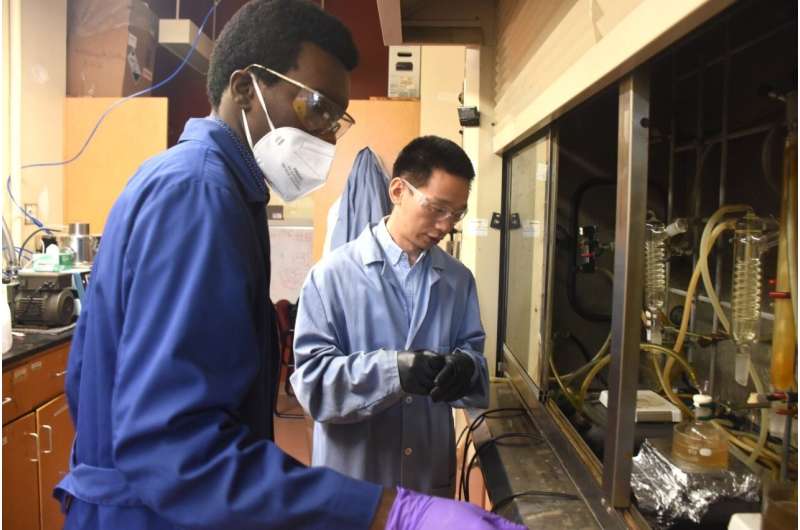New Polyolefin Recycling Technology Has Commercial Promise

Virginia Tech researchers cite benefits of plastics soap process in commercial scale-up
In a previous post (Aug. 16) we discussed a technology developed at Virginia Tech University, in which the long-chain molecules of waste polyolefins—HDPE, LDPE, PE, PP and PE/PP mix—are converted by a process called temperature-gradient thermolysis into short-chain waxes that can be used as precursors to soap.
The developer, Dr. Guoliang Liu, associate professor of chemistry in the College of Science, and his research team of two PhD candidates in chemistry, wrote that the process can be scaled up and used profitably in commercial production. Based on a technoeconomic analysis (TEA) of a commercial version of the process included in the paper Dr. Liu and his team published in the Aug. 10 issue of Science (“Chemical upcycling of polyethylene, polypropylene and mixtures to high-value surfactants”), a 10,000-ton/year process plant would be profitable based on raw material costs in 2022 and other conditions.
Among factors that could initially favor process economics is a disparity in price of polyolefin waste compared with soaps and detergents. In a statement released by Virginia Tech about the process, it was noted that “although soaps may not initially seem like a particularly expensive commodity, they can … be worth double or triple the price of plastics when compared by weight. Currently, the average price of soap and detergent amounts to about $3,550 per metric ton, and that of polyethylene is about $1,150 per metric ton. Furthermore, the demand for soaps and related products is comparable to the demand for plastics.”
Process Software Analyzes and Adjusts Operating Conditions
Dr. Liu and team used simulation software developed by Aspen Technology called Advanced System for Process Engineering to calculate operational numbers. The software allows the design and optimization of a range of processes such as chemical reactions, separation processes and heat/mass transfer operations. The software defines process flow by selecting components like reactors, distillation columns, heat exchangers and other unit operations. It specifies operating conditions for each unit, such as temperature, pressure and flow rates. And it optimizes process design by adjusting operating conditions, process components or both.
The financial numbers that Liu and his team included in the paper are detailed and adjustable based on the types of equipment, refining processes and add-on steps specified for a commercial operation.
Weighing the Pros and Cons of Current Recycling Options
A supplementary discussion in the paper contrasts the pros and cons of current recycling operations and biobased alternatives to fossil fuel plastics. Examining them and comparing their results to those of temperature-gradient thermolysis could also make a strong case for investment in the process on a commercial scale.
For example, Dr. Liu and team note that while mechanical recycling dominates the market with a 90 percent share, it has challenges. These include high process temperatures (⁓300°C/572°F) that compromise the structural stability and mechanical strength of recycled products; blending recyclate with virgin plastics at high loadings (70 wt.% or more); and a cooling process that can cause water pollution.
Advanced or chemical recycling is a promising way of upscaling recycled plastics to virgin properties. However, depolymerization of PE and PP to monomers is not thermodynamically favorable, the researchers write, claiming that typical PE and PP depolymerization yields are < 10 percent. Although significant progress has been made in this area, the highest yield to date—around 40 percent—is still far from being industrially practical, they state.
Even biobased plastics have problems. “The market insertion of new materials is a long process,” Liu and company wrote. “Currently, bioplastics have a market volume of < 1 percent [in 2022] and are about 20 to 100 percent more expensive than petroleum-based plastics. Due to the small market share of bioplastics, high demand for proper recycling/upcycling of existing waste persists.
“Additionally, the sourcing of bioplastics involves agricultural practices and land use.” The paper notes that “farmland is a scarce resource, and its reduced productivity threatens the stability of the bioplastic supply chain. Therefore, the wide utilization of bioplastics may require further interdisciplinary research and development in chemistry, agriculture, biology, logistics, land management and many other [areas].”
The conclusion taken from the process observations and arguments appears to be that a commercial polyolefin recycling operation based on temperature-gradient thermolysis could be profitable for companies willing to make the investment. Now the question is: which company—or investor—might step up and make it happen?
